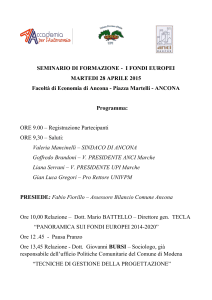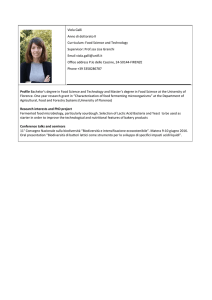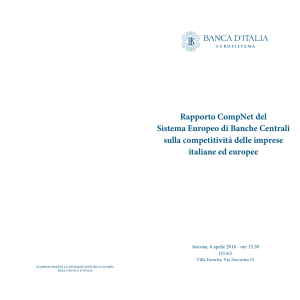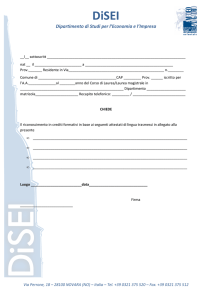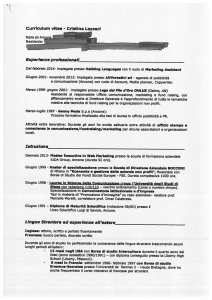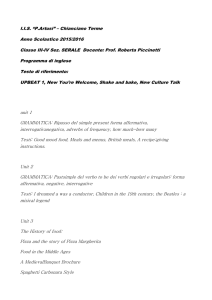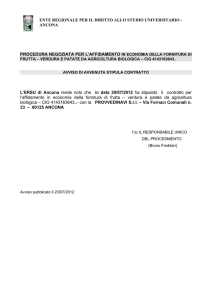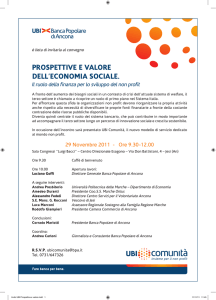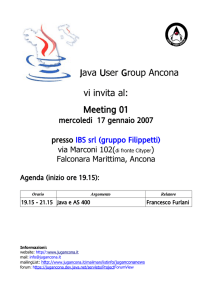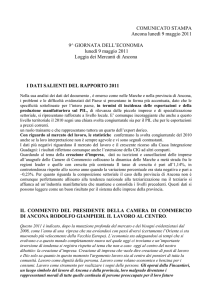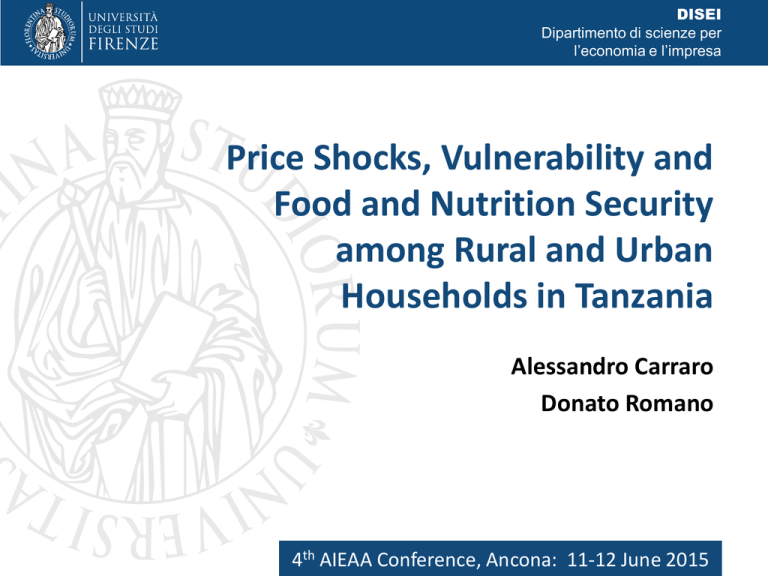
DISEI
Dipartimento di scienze per
l’economia e l’impresa
Price Shocks, Vulnerability and
Food and Nutrition Security
among Rural and Urban
Households in Tanzania
Alessandro Carraro
Donato Romano
4th AIEAA Conference, Ancona: 11-12 June 2015
DISEI
Dipartimento di scienze per
l’economia e l’impresa
11-12 June 2015
4th AIEAA Conference, Ancona
Innovation, productivity and growth: towards sustainable agri-food production
The starting point
The price crisis: same pattern across districts
Source: WFP-VAM (2014)
2
DISEI
Dipartimento di scienze per
l’economia e l’impresa
11-12 June 2015
4th AIEAA Conference, Ancona
Innovation, productivity and growth: towards sustainable agri-food production
The starting point
Incidence of a
single/multiple
shock on
Tanzanian HHs
3
Source: TNPS
DISEI
Dipartimento di scienze per
l’economia e l’impresa
11-12 June 2015
4th AIEAA Conference, Ancona
Innovation, productivity and growth: towards sustainable agri-food production
Literature on the topic
• The effects of prices on poverty are commodityspecific, country-specific and household-specific
(Ravallion and Lokshin, 2004; Hertel and Winters, 2006, Aksoy
and Izik-Dimelik, 2008; Ivanic and Martin, 2008; Polaski, 2008;
Wodon et al., 2008; Sarris and Rapsomanikis, 2009; Wodon and
Zaman, 2010; Ivanic et al., 2012)
• Effect of price surges on caloric and macro/micronutrients intake (Jensen and Miller, 2008; Brinkman et al.,
2010; Harttgen and Klasen, 2012; Alem and Sodebrom, 2012;
Zaki et al. 2014; D'Souza and Jolliffe, 2014)
• Relevant contributions for Tanzania, but before the
most recent food price spikes (Christiansen et al., 2006;
Sarris and Karfakis, 2007)
4
DISEI
Dipartimento di scienze per
l’economia e l’impresa
11-12 June 2015
4th AIEAA Conference, Ancona
Innovation, productivity and growth: towards sustainable agri-food production
Research questions
• overall obj.: effects of recent food price shocks (and
other covariate and idiosyncratic shocks) on food
consumption across Tanzanian HHs in urban and rural
areas
• vulnerability as uninsured exposure to risk (VER):
- impact of price shocks both on household food caloric intake
(quantity) and dietary diversity (quality)
- why certain types of HHs are more vulnerable than others,
controlling also for the severity of the event
- macro and micro-nutrients’ deficiencies among regions: role
played by financial deepening in a context of domestic price
volatility
5
DISEI
Dipartimento di scienze per
l’economia e l’impresa
11-12 June 2015
4th AIEAA Conference, Ancona
Innovation, productivity and growth: towards sustainable agri-food production
Data
• HH data from the 2008/09, 2010/11 and 2012/13
Tanzania National Panel Survey (part of LSMS - ISA)
- TZNPS Y1: 3,265 households and 16,709 individuals
- TZNPS Y2: 3,924 households and 20,559 individuals
- TZNPS Y3: 5,010 households and 25,412 individuals
• multi-stage, stratified, random sampling of Tanzanian
HHs
• representative at the national, urban/rural, and agroecological level
• final sample: 58,022 units
6
DISEI
Dipartimento di scienze per
l’economia e l’impresa
11-12 June 2015
4th AIEAA Conference, Ancona
Innovation, productivity and growth: towards sustainable agri-food production
Food caloric intake: fixed effect
Specification
yijt
Pjt
Sjt
Xit
Zjt
γij
ηt
ln(food caloric intake)
vector of price shock variables
vector of non-price shock variables
vector of variables of individual characteristics
vector of household characteristics
individual time-invariant fixed effects
year effects
7
DISEI
Dipartimento di scienze per
l’economia e l’impresa
11-12 June 2015
4th AIEAA Conference, Ancona
Innovation, productivity and growth: towards sustainable agri-food production
Effect of shocks on food caloric intake
8
DISEI
Dipartimento di scienze per
l’economia e l’impresa
11-12 June 2015
4th AIEAA Conference, Ancona
Innovation, productivity and growth: towards sustainable agri-food production
Effect of shocks on food caloric intake
Market
participation:
net-sellers vs.
net-buyers
9
DISEI
Dipartimento di scienze per
l’economia e l’impresa
11-12 June 2015
4th AIEAA Conference, Ancona
Innovation, productivity and growth: towards sustainable agri-food production
Food Consumption Score
FCS = astaple xstaple + apulses xpulses + avegetables xvegetables +
afruit xfruit + aanimal xanimal + asugar xsugar + adairy xdairy +
aoil xoil
xi frequencies of food consumption = number of days for
which each food group was consumed over the past 7
days
ai weight of each food group
10
DISEI
Dipartimento di scienze per
l’economia e l’impresa
11-12 June 2015
4th AIEAA Conference, Ancona
Innovation, productivity and growth: towards sustainable agri-food production
Food Consumption Score: estimates
11
DISEI
Dipartimento di scienze per
l’economia e l’impresa
11-12 June 2015
4th AIEAA Conference, Ancona
Innovation, productivity and growth: towards sustainable agri-food production
Macro and micro nutrients intake
• carbohydrates intake (g/person/day)
• proteins intake (g/person/day)
12
DISEI
Dipartimento di scienze per
l’economia e l’impresa
11-12 June 2015
4th AIEAA Conference, Ancona
Innovation, productivity and growth: towards sustainable agri-food production
Macro and micro nutrients intake
• zinc intake (g/person/day)
• vitamin A intake (mg/person/day)
13
DISEI
Dipartimento di scienze per
l’economia e l’impresa
11-12 June 2015
4th AIEAA Conference, Ancona
Innovation, productivity and growth: towards sustainable agri-food production
Concluding remarks
• price instability together with natural disasters
are among the most experienced shocks among
Tanzanian households
• the sensitivity of food intake variation to food
price shocks is different among rural and urban
households
• food price rise and food price fall affect (-) and
(+) both quantity and quality of food consumed
14
DISEI
Dipartimento di scienze per
l’economia e l’impresa
11-12 June 2015
4th AIEAA Conference, Ancona
Innovation, productivity and growth: towards sustainable agri-food production
Concluding remarks
• a mix of price stabilizing policies and food
fortification programs need to be implemented
at local level to improve the quality of the diet
• interventions should prioritize that regions
exhibiting a deficit in macro/micro nutrients
absorption (i.e. fats, calcium and vitamin-A)
15
DISEI
Dipartimento di scienze per
l’economia e l’impresa
11-12 June 2015
4th AIEAA Conference, Ancona
Innovation, productivity and growth: towards sustainable agri-food production
Thank you
[email protected]
[email protected]
16

